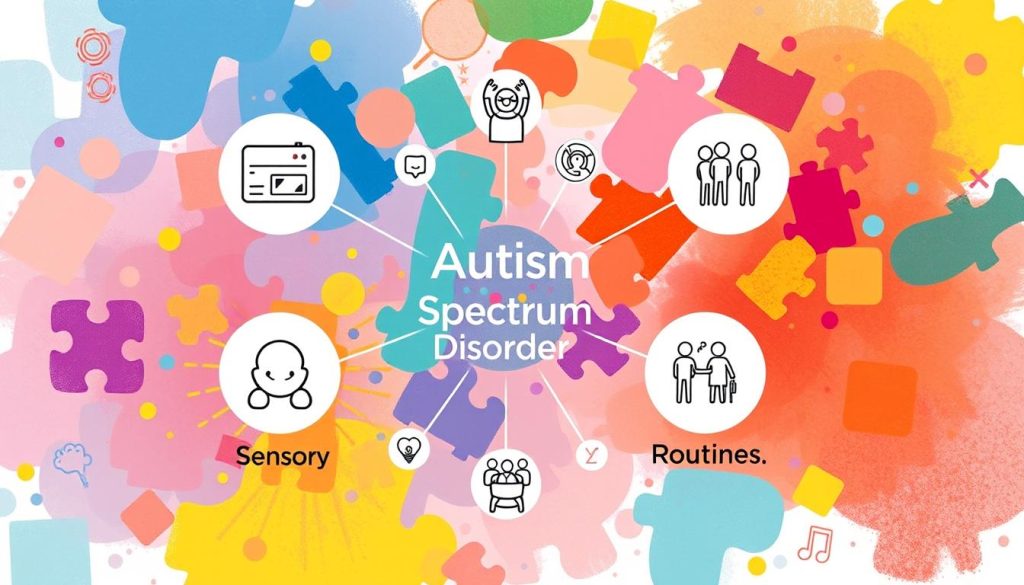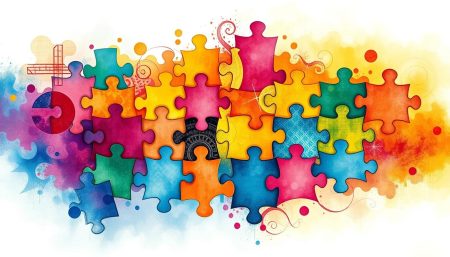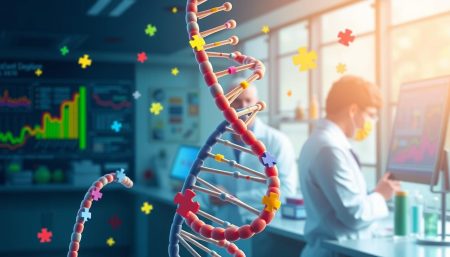The fifth edition of the Diagnostic and Statistical Manual of Mental Disorders (DSM-5) changed how we see Autism Spectrum Disorder (ASD). Published by the American Psychiatric Association, it’s key to understanding ASD. The Autism Spectrum Disorder DSM-5 criteria show how different symptoms can affect people in different ways.
The DSM-5 autism diagnosis criteria are important. Places like the Centers for Disease Control and Prevention (CDC) use them to track ASD. These criteria keep getting better thanks to autism research studies. This shows how the understanding of ASD is always growing.
Understanding Autism Spectrum Disorder
Autism Spectrum Disorder (ASD) is a complex condition. It affects social interaction, communication, and behavior. Over the years, doctors have learned more about ASD. This has led to changes in how they diagnose it.
What is Autism Spectrum Disorder?
The World Health Organization defines ASD. It involves challenges in social skills, communication, and repetitive behaviors. ASD starts in childhood and can last a lifetime. Some people with ASD live independently, while others need constant care.
Historical Perspective on Autism Diagnosis
The history of diagnosing autism has seen big changes. In the early 20th century, doctors first noticed symptoms similar to autism. Leo Kanner’s 1943 study made “autism” an official term. The criteria for diagnosing autism have been updated many times, with major changes in the DSM-5.
| Criteria | DSM-IV | DSM-5 |
|---|---|---|
| Social Interaction and Communication | Three separate criteria | Combined into one criterion |
| Behavior Patterns | At least one of four types of repetitive behaviors | At least two types of repetitive behaviors |
| Age of Onset | Manifestations before the age of 3 years | Symptoms must be present in the early developmental period |
The shift from DSM-IV to DSM-5 shows how much we’ve learned about ASD. It highlights the need for updated criteria in diagnosis and treatment.
The Importance of DSM-5 in ASD Diagnosis
The fifth edition of the Diagnostic and Statistical Manual of Mental Disorders (DSM-5) is key in diagnosing Autism Spectrum Disorder (ASD). It introduced the ASD DSM-5 classification, marking a big change. This change recognizes autism as a spectrum, with different levels of symptoms.
The DSM-5 made a big improvement by simplifying the DSM-5 criteria for autism. It now groups different conditions under one category. This makes diagnosis more flexible, helping tailor treatments to each person’s needs.
Health professionals and researchers see the pivotal role of DSM-5 in understanding and treating ASD. The unified criteria have also reduced diagnosis errors. This ensures everyone gets the support they need.
Many people, including doctors, parents, and caregivers, agree on the DSM-5’s value. The new criteria have made diagnosis easier and improved access to services. This has greatly helped many families.
In summary, the DSM-5 is vital for autism diagnosis. Its detailed approach helps understand the spectrum better. This leads to more effective and personalized treatments.
Autism Spectrum Disorder DSM-5 Criteria
From DSM-IV to DSM-5, diagnosing ASD has evolved. This change helps us better understand the disorder. It’s key for professionals and caregivers to grasp these updates to support those with autism.
Core Features of ASD in DSM-5
The DSM-5 lists key symptoms of ASD. These include problems with social communication and interaction. It also mentions repetitive behaviors and interests. These signs must appear early and affect daily life.
Changes from DSM-IV to DSM-5
The DSM-5 brings big changes in autism diagnosis. Unlike DSM-IV, it no longer separates Autistic Disorder, Asperger’s Disorder, and PDD-NOS. Now, all fall under one diagnosis: ASD.
| Criteria | DSM-IV | DSM-5 |
|---|---|---|
| Diagnostic Categories | Three separate disorders | Consolidated into single ASD diagnosis |
| Core Symptoms | More emphasis on triadic symptoms | Two main domains: Social Communication and Repetitive Behaviors |
| Severity Levels | Not defined | Three levels of support needs specified |
The Role of Behavioral Assessment in Autism
Behavioral assessment in ASD is key to understanding each person’s unique challenges. Clinicians rely heavily on these assessments to find the best ways to help. This detailed look is vital for both diagnosis and ongoing care.
Studies from the American Journal of Occupational Therapy show how important behavioral assessment in ASD is. It gives vital information that shapes treatment plans. This tailored approach helps individuals better interact and function in their daily lives.
- ASD assessment criteria are essential for identifying Autism Spectrum Disorders.
- Regular re-assessments help adjust interventions as needed.
Case studies from various clinics highlight the value of behavioral assessments. They reveal underlying issues not seen by other methods. This method also helps tell ASD apart from other developmental disorders with similar behaviors.
| Assessment Type | Focus Area | Relevance to ASD |
|---|---|---|
| Direct Observation | Behavior in natural settings | High |
| Parent Interviews | Historical behaviors, family impact | Moderate-High |
| Structured Interaction | Social and communication skills | High |

Experts, as mentioned by the American Journal of Occupational Therapy, suggest integrating behavioral signs into broader diagnostic criteria. This approach offers a clearer view of the autism spectrum. It helps in creating personalized treatment plans.
Using both direct and indirect assessment methods in a behavioral framework greatly improves our understanding and support of those with autism. It leads to better care and development outcomes. Ultimately, examining ASD behaviors through structured assessments is key to ensuring individuals get the right support to thrive.
DSM-5 Criteria for Autism: A Closer Look
The DSM-5 autism diagnosis process is based on clear criteria. These criteria help understand the complex nature of autism spectrum disorders (ASD). By deeply understanding these criteria, doctors can give more precise and personalized care. This greatly improves the lives of those with autism and their families.
The Review of Educational Research gives a detailed look at these criteria. It shows how they help tell autism apart from other developmental disorders. It also highlights how they cover the wide range of autism in different age groups. Clinical reports also show how these criteria work well in real-world diagnoses. They help doctors make consistent diagnoses, no matter where they work.
Stories from patients and their families add a lot to the conversation on DSM-5 autism diagnosis. They share personal experiences that show the real-life effects of the diagnostic process. These stories are very important. They help us see how the criteria affect everyday life, making a strong case for improving the DSM-5.
| Feature | Description | Impact on Diagnosis |
|---|---|---|
| Consistency across Age Groups | DSM-5 Criteria are structured to be applicable across all ages, considering the developmental changes that occur over time. | Enhances reliability of diagnosis from early childhood through to adulthood. |
| Behavioral Examples | Specific examples of behavior that comply with diagnostic criteria. | Assists practitioners in identifying relevant symptoms, increasing diagnostic accuracy. |
| Separation from Other Disorders | Clear delineation from other developmental disorders with overlapping symptoms. | Reduces misdiagnosis and ensures appropriate treatment and support. |
This table shows how detailed and flexible the DSM-5 criteria are. Using these criteria well is key to improving diagnosis and treatment. This can greatly change the lives of those with autism.
Defining the Spectrum: Categories of ASD
The term Autism Spectrum Disorder covers a wide range of conditions. Each one needs different levels of support. Knowing these ASD classification levels helps in providing the right help and support. The DSM-5 breaks these into three main autism spectrum levels of support. This helps professionals and families better understand and manage ASD.
Level 1: Requiring Support
People at Level 1 need some support but can be more independent. They can talk and interact socially, but may find it hard to organize and plan. This affects their daily functioning.
Level 2: Requiring Substantial Support
Those at Level 2 need more support than Level 1. They have big challenges with talking and interacting socially. They need a lot of help with social and communication therapies and daily living.
Level 3: Requiring Very Substantial Support
Level 3 is for those with severe communication problems. They have big trouble in social situations. They need a lot of help every day and often rely on caregivers for safety and daily tasks.
| ASD Level | Description | Type of Support Required |
|---|---|---|
| Level 1 | Difficulty with organization and planning affecting independence | Needs support in organization and social interactions |
| Level 2 | Marked deficits in verbal and non-verbal social communication skills | Substantial support, structured social communication therapy |
| Level 3 | Severe deficits in communication, very limited social response | Very substantial support, constant caregiver presence |
Assessing ASD: A Multi-Disciplinary Approach
In the field of autism diagnosis, a multidisciplinary ASD assessment is widely regarded as the most effective strategy. It ensures accurate and complete understanding and support. This method uses the diverse skills of various professionals, each bringing unique insights to the diagnosis process.
Role of Psychologists and Psychiatrists
Psychologists and psychiatrists are key in the multidisciplinary team. They focus on detailed behavioral evaluations and mental health assessments. Their knowledge in psychologists and ASD management helps to accurately diagnose autism. This ensures the diagnosis meets the individual’s specific needs.
Input from Educational Professionals
Educational professionals are vital in multidisciplinary ASD assessments. They help understand how autism affects learning and adaptation in school. Their input is essential for creating individualized educational plans that meet diagnosed needs. The teamwork between educational professionals in ASD diagnosis and clinical experts leads to a more complete and practical diagnosis. This helps in providing better educational support.
| Expertise | Role in ASD Assessment | Benefits |
|---|---|---|
| Psychologists | Behavioral assessment, differential diagnosis | Accurate identification of ASD-related symptoms |
| Psychiatrists | Mental health evaluation, medication management | Address co-occurring mental health issues |
| Educational Professionals | Educational impact assessment, learning support planning | Enhanced academic and social support tailored to individual ASD needs |
Communication and Social Interaction in ASD
Understanding autism communication challenges and social interaction is key. It helps us see how people with autism experience and interact with the world. New studies in speech and language pathology show big hurdles in talking and non-verbal communication. Developmental psychology also helps us understand social relationships and behaviors in those with ASD.
Verbal and Non-Verbal Communication Challenges
People with autism face special challenges in talking and non-verbal communication. Some may repeat words or take things very literally, making it hard to have smooth conversations. They might also struggle with body language and facial expressions, leading to misunderstandings.
Social Relationships and Behaviors
How people with autism interact socially can vary a lot. Some find it hard to make and keep friends because of trouble understanding social clues. This can lead to feeling lonely or having problems with friends, making it tough to have deep conversations.

To help, applied behavioral analysis offers ways to improve communication and social skills. This includes training in social skills and communication therapy. These efforts aim to help individuals interact better with those around them.
Behavioral Patterns and Fixated Interests
Exploring repetitive behaviors in ASD and special interests in autism gives us a peek into their daily lives. These are not just habits. They show how those with autism process the world differently.
Repetitive behaviors in ASD include actions like hand-flapping or arranging objects. These behaviors are frequent and seem compulsive. Yet, they bring comfort and stability to those with autism, even if they seem odd to others.
Special interests in autism are intense and focused. They can be anything from dinosaurs to vacuum cleaners. These interests bring joy and help with learning and socializing.
- Development of social skills through themed interests
- Enhancement of cognitive capabilities such as memory and concentration
- Reduction in anxiety through predictable, controlled aspects of their environment
| Behavior | Function | Therapeutic Approach |
|---|---|---|
| Repetitive Movements | Sensory stimulation, anxiety reduction | Structured behavioral interventions, sensory-friendly environments |
| Deep Interests | Information processing, engagement | Incorporation into educational and social activities |
The conversation about repetitive behaviors in ASD and special interests in autism is changing. New research shows these traits can help with learning and life quality. By understanding and using these behaviors, we can improve education and life for those with ASD.
Impact of Sensory Processing on ASD Diagnosis
Understanding sensory processing in ASD is key for a good autism diagnosis. People with autism might feel too much or too little of certain things. This affects how they live their day and how they connect with others.
In clinics, sensory issues are seen as important. They help doctors understand ASD better. These sensory reactions give deep insights into autism’s details.
- Impact on Social Skills: Sensory sensitivities can change how people with autism act around others and their surroundings.
- Behavioral Responses: Too much or too little reaction to sensory input can show in behaviors. These are important for diagnosing ASD.
- Communication Challenges: Sensory overload can make talking harder. This shows why looking at sensory processing is so important during assessments.
So, knowing about sensory processing is essential in diagnosing autism. It helps doctors see all the symptoms people with ASD might have. This makes the diagnosis more complete.
Co-occurring Conditions and Differential Diagnosis
Autism Spectrum Disorder (ASD) often comes with other conditions, making diagnosis harder. It’s key to understand and spot these conditions for effective treatment.
Co-occurring conditions in ASD include various behavioral, developmental, and psychological disorders. Kids and adults with ASD might also have ADHD, anxiety, and sensory issues. These can change how they function and what treatments they need.
| Condition | Prevalence in ASD | Impact on Diagnosis |
|---|---|---|
| ADHD | 30-50% | Complicates focus and attention assessment |
| Anxiety Disorders | 40% | Influences social interaction and behavior |
| Sensory Processing Disorders | 60-70% | Affects response to environmental stimuli |
Getting a correct differential diagnosis of autism means telling ASD apart from other disorders. This is tricky because symptoms can look similar, mainly in young children.
- Detailed behavioral assessments are key.
- Getting opinions from different experts helps.
- Watching how symptoms change over time is important.
Diagnosing autism is hard because it can show up in many ways. Some people have mild symptoms, while others have more severe ones. This means each person needs a treatment plan that fits their needs.
ASD Assessment Criteria According to DSM-5
Professionals use the DSM-5 criteria to check for ASD symptoms. This method helps them see and measure the challenges and behaviors of autism spectrum disorder.
Evaluating Social Communication and Interaction
They look at several important areas for diagnosing ASD. They check how people start conversations and react to others. They also see if they can keep a conversation going.
They look at nonverbal signs like body language and how people adjust their communication in different situations. It’s also important to see if they have meaningful relationships beyond just talking.
Assessing Restricted, Repetitive Behaviors
They watch for repetitive actions, like hand movements or speech patterns. They also check for a need for sameness and strict routines.
They look at intense interests that are not normal. And they check for unusual reactions to sensory things, like not feeling pain or touching things too much.
| Clinical Observation | Social Communication | Repetitive Behaviors |
|---|---|---|
| Initiation of Interaction | Assess ability to start interactions | N/A |
| Response to Social Overtures | Analyze responsiveness to social cues | N/A |
| Conversation Maintenance | Measure the ability to sustain conversation | N/A |
| Adaptation to Context | Evaluate changes in behavior per context | N/A |
| Nonverbal Communication | Observe use of gestures and facial expressions | N/A |
| Flexibility in Behavior | N/A | Assess resistance to change |
| Intensity of Interests | N/A | Monitor depth of fixated interests |
| Sensory Sensitivities | N/A | Examine response to sensory stimuli |
Age Considerations in DSM-5 Autism Diagnosis
Understanding and identifying autism spectrum disorder (ASD) changes with age. This presents unique challenges for both initial recognition and subsequent diagnoses. It’s important to explore how age impacts the diagnostic process to ensure timely and appropriate interventions.
Symptoms in Early Development
The early signs of autism often appear before a child is three. Symptoms include minimal eye contact, limited interest in social interactions, and delays in speech and language skills. Recognizing these signs early is key for screening younger children.
Longitudinal studies show the importance of monitoring from infancy to preschool age. This helps observe the development or intensification of these symptoms.
Diagnosing ASD in Adults
Diagnosing autism in adulthood has its own challenges. Adults may seek diagnosis due to lifelong social integration or employment struggles. Many adults have developed coping mechanisms that might mask ASD symptoms, making diagnosis harder.
Adults also face significant hurdles in accessing diagnostic services. These services are mainly designed for children.
The nuances of diagnosing ASD across different life stages require a flexible, sensitive approach. This approach should be tailored to the individual’s developmental history and current needs.
| Age Group | Common Challenges | Key Focus for Diagnosis |
|---|---|---|
| Infants & Toddlers | Identification of non-verbal cues, parent-reported concerns | Early developmental screenings, parental interviews |
| Adults | Subtle symptom presentation, self-recognition of social challenges | Comprehensive adult psychiatric evaluations, history taking |
Integrating DSM-5 Criteria into Treatment Planning
Using autism spectrum disorder diagnostic guidelines is key for good treatment planning for ASD. The DSM-5 is a guide for doctors to make plans for each person. It helps find the right treatment by looking at each person’s needs closely.
Experts talk about how knowing the right diagnosis helps in treatment. They say that using the DSM-5 makes therapy more effective. This means therapy can really help people with autism.
People who get help and those who help them say it makes a big difference. Knowing the DSM-5 helps make therapy better. It lets therapists give the best support and companies can improve their help too.
FAQ
Q: What is Autism Spectrum Disorder?
A: Autism Spectrum Disorder (ASD) is a developmental disorder. It makes social interaction and communication hard. It also causes repetitive behaviors. These symptoms start early and affect daily life.
Q: How does the DSM-5 classify Autism Spectrum Disorder?
A: The DSM-5 groups ASD into one diagnosis. It includes disorders like autistic disorder and Asperger’s syndrome. This change helps simplify diagnosis.
Q: What are the core features of ASD as outlined in the DSM-5?
A: The DSM-5 says ASD has two main parts. First, there are problems with social communication and interaction. Second, there are repetitive behaviors and interests.
Q: How have the criteria for diagnosing autism changed from DSM-IV to DSM-5?
A: The DSM-5 has made big changes. It now has one category for ASD. It also looks more at sensory issues and how severe symptoms are.
Q: Why is behavioral assessment important in diagnosing ASD?
A: Behavioral assessment is key for ASD diagnosis. It checks for social, communication, and repetitive behavior problems. This helps doctors understand the severity of symptoms.
Q: What are the different levels of support for ASD specified in the DSM-5?
A: The DSM-5 talks about three support levels for ASD. Level 1 needs support, Level 2 needs a lot, and Level 3 needs a lot more. These levels show how much help someone needs.
Q: How do psychologists and educational professionals collaborate in diagnosing ASD?
A: Psychologists and educators work together to diagnose ASD. They use their skills to assess a child’s abilities. This helps them give the right support.
Q: What kind of communication challenges are associated with ASD?
A: People with ASD face many communication challenges. They might struggle with talking, understanding tone, and body language. They also find it hard with idioms and humor.
Q: How are repetitive behaviors and fixated interests significant in ASD diagnosis?
A: Repetitive behaviors and interests are key in ASD diagnosis. They can be seen as repetitive movements or a strong interest in something. These are important signs of ASD.
Q: In what ways can sensory processing impact ASD diagnosis?
A: Sensory processing issues are common in ASD. They can affect behavior and daily life. These issues are part of the diagnosis criteria and are very important.
Q: What are some co-occurring conditions that can affect ASD diagnosis?
A: ASD often comes with other conditions like ADHD and anxiety. These can make diagnosis harder. It’s important to evaluate them carefully for accurate diagnosis and treatment.
Q: How does DSM-5 address the assessment of social communication and interaction in ASD?
A: The DSM-5 has specific criteria for social communication and interaction in ASD. It looks at social-emotional reciprocity and developing relationships. This helps in diagnosing ASD.
Q: How are restricted and repetitive behaviors assessed in ASD diagnosis according to DSM-5?
A: The DSM-5 checks for repetitive behaviors in ASD. It looks for repetitive movements, use of objects, and fixated interests. These are signs of ASD.
Q: What are the considerations for diagnosing ASD in adults?
A: Diagnosing ASD in adults is different. Symptoms may not be as obvious as in children. It’s important to look at past behavior and consider how the person has adapted.
Q: How is the DSM-5 criteria incorporated into treatment planning for ASD?
A: The DSM-5 criteria help create a treatment plan for ASD. They highlight strengths and challenges. This ensures the treatment is tailored to the individual’s needs, improving outcomes.


















